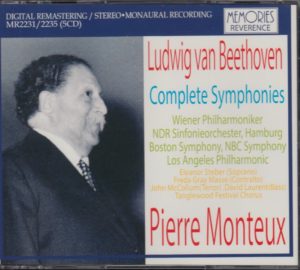 This morning’s conductor of Beethoven’s Symphony No. 1 in C Major is a fellow I had never heard of before, Frenchman (Pierre Monteux), on an Italian record label I’d never heard of before (Memories Reverence).
This morning’s conductor of Beethoven’s Symphony No. 1 in C Major is a fellow I had never heard of before, Frenchman (Pierre Monteux), on an Italian record label I’d never heard of before (Memories Reverence).
And those two reasons are precisely why I chose this no-frills box set.
And I do mean no frills.
There are no liner notes (boo! hiss!), no information about the conductor (boo! hiss!), no information about the orchestra (boo! hiss!), no information about the recording itself, such as why was it chosen? (boo! hiss!), no information about the record label (boo! hiss!), no information about the recording engineers (boo! hiss!), no running time for each movement (boo! hiss!). This box set is merely a CD jewel case that holds five CDs – CDs that aren’t even numbered, by the way.
Perfect.
This could be a diamond in the rough, or it could be a dud. Either way, this odd cycle of Beethoven’s symphonies is going to be fun to explore.
First of all, I’m surprised Maestro Monteux’s Wikipedia bio is so extensive, much longer than Franz Konwitschny’s, for example. Monteux seemed to have been a much-loved and -respected conductor.
Pierre Benjamin Monteux (4 April 1875 – 1 July 1964) was a French (later American) conductor. After violin and viola studies, and a decade as an orchestral player and occasional conductor, he began to receive regular conducting engagements in 1907. He came to prominence when, for Sergei Diaghilev’s Ballets Russes company between 1911 and 1914, he conducted the world premieres of Stravinsky’s The Rite of Spring and other prominent works including Petrushka, Ravel’s Daphnis et Chloé, and Debussy’s Jeux. Thereafter he directed orchestras around the world for more than half a century.
Monteux was well known as a teacher. In 1932 he began a conducting class in Paris, which he developed into a summer school that was later moved to his summer home in Les Baux in the south of France. After moving permanently to the US in 1942, and taking American citizenship, he founded a school for conductors and orchestral musicians in Hancock, Maine. Among his students in France and America who went on to international fame were Lorin Maazel, Igor Markevitch, Neville Marriner, Seiji Ozawa, André Previn and David Zinman. The school in Hancock has continued since Monteux’s death.
Reputation and repertoire
The record producer John Culshaw described Monteux as “that rarest of beings – a conductor who was loved by his orchestras … to call him a legend would be to understate the case.” Toscanini observed that Monteux had the best baton technique he had ever seen. Like Toscanini, Monteux insisted on the traditional orchestral layout with first and second violins to the conductor’s left and right, believing that this gave a better representation of string detail than grouping all the violins together on the left.[n 15] On fidelity to composers’ scores, Monteux’s biographer John Canarina ranks him with Klemperer and above even Toscanini, whose reputation for strict adherence to the score was, in Canarina’s view, less justified than Monteux’s.
According to the biographical sketch in Grove Dictionary of Music and Musicians, Monteux “was never an ostentatious conductor … [he prepared] his orchestra in often arduous rehearsals and then [used] small but decisive gestures to obtain playing of fine texture, careful detail and powerful rhythmic energy, retaining to the last his extraordinary grasp of musical structure and a faultless ear for sound quality.” Monteux was extremely economical with words and gestures and expected a response from his smallest movement. The record producer Erik Smith recalled of Monteux’s rehearsals with the Vienna Philharmonic for Beethoven’s Pastoral Symphony and Brahms’s Second, “although he could not speak to the orchestra in German, he transformed their playing from one take to the next”.
There’s a lot more to read on his Wiki page. Given his extensive accomplishments, I’m surprised he isn’t more well known today. His Monteux School and Music Festival continues to this day.
Fascinating.
See? This is why I do these musical projects. I love discovering such things!
 Despite all the newness, there is something familiar about today’s recording: The orchestra is the Wiener Philharmoniker, which I have encountered before in my explorations.
Despite all the newness, there is something familiar about today’s recording: The orchestra is the Wiener Philharmoniker, which I have encountered before in my explorations.
Beethoven wrote his symphonies in four parts (except for the Sixth, which is in five). The time breakdown of this one (Symphony No. 1 in C Major), from this particular conductor (Monteux, at age 85) and this particular orchestra (Weiner Philharmonker), at this particular time in history (April 1960) on this particular record label (Memories Reverence) is as follows:
I. Adagio molto………………………………………………………………………………..9:01
II. Andante cantabile con moto………………………………………………………6:10
III. Menuetto. Allegro molto e vivace……………………………………………….3:25
IV. Adagio – Allegro molto e vivace…………………………………………………5:56
Total running time: 24:32
My Rating:
Recording quality: 4 (noticeable tape hiss; but remarkably clear otherwise)
Overall musicianship: 5
CD liner notes: 0 (no liner notes – boo! hiss!)
How does this make me feel: 5
This is a spectacular recording despite its 58-year-old age. It is muscular and energetic, particularly the third movement (Meuetto. Allegro molto e). That’s one powerful three minutes and 25 seconds, I can tell you.
The Finale is also quite splendid, with lots of verve.
I did not know anything about Maestro Monteux before today. But this is a splendid, and brisk-feeling performance of Beethoven’s Symphony No. 1.
Despite the lack of liner notes, which is usually a deal breaker for me, I have to give this a resounding “Huzzah!’ It pushes all the right buttons for me, possibly because it’s such a rare recording. That makes it even more special to me.
If you can find this set, I heartily recommend it.
